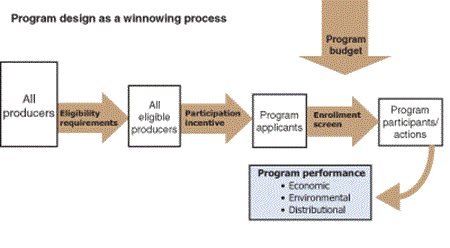A Multitude of Design Decisions Influence Conservation Program Performance
Designing a voluntary conservation program requires several types of decision criteria to encourage farmers to apply and to determine who can participate in the program. These decisions act as a winnowing process, starting with all farmers and ranchers and resulting in a pool of program participants. Eligibility requirements determine which producers can apply, based on type of farm (e.g., crops versus livestock), resource concerns (e.g., erodible lands), or geographic locations. Participation incentives (payment levels) specify what actions (e.g., application of a conservation practice) or levels of environmental performance qualify for payments and how large the payments will be. Payment rates can be fixed or set by bidding. Enrollment screens determine which applicants are accepted: They range from first-come, first served to the use of a benefit-cost index to rank applications by expected performance. Once these design decisions are made, most actions by program managers to meet program objectives are locked in place.
A recent ERS report finds that conservation program design features that promote the highest level of environmental benefits per program dollar include structuring the application process for enrolling farm operators as a “request for proposals,” including the benefits and costs of enrollment; establishing a bidding process for financial assistance; and using a benefit/cost ranking to select program enrollees. ERS research exploring specific aspects of program design highlights the many tradeoffs involved:
- Achieving environmental and income objectives with a single program involves tradeoffs in terms of which goal is emphasized. Conservation programs can support farm income but at a potential cost in terms of environmental gains. Commodity programs can be made “greener” but likely will not fix every agri-environmental problem or do so efficiently.
- “Targeting” conservation efforts through eligibility requirements, participation incentives, or enrollment screens can be used to focus payments on fields, practices, or specific resource concerns most likely to generate the greatest environmental benefits.
- Bidding—a process in which farmers compete in an auction for conservation payment contracts—can reveal the costs of participating and the benefits program applicants would likely supply. Feeding those bids into benefit-cost indices to enroll producers enhances the cost effectiveness of conservation programs.
- Programs that retire land award payments based on different actions than those focused on working lands, resulting in different benefits and tradeoffs. Land retirement generally provides greater environmental benefits (per contract acre) but at a higher cost than a working land program, in which land remains in production.
- Similarly, paying farmers to adopt specific conservation practices and paying for the level of environmental performance are two different approaches with distinct benefits. Paying for performance is more cost effective than paying for practices because program incentives are directly linked to the environmental indicator of interest. However, agri-environmental performance is not easily observable, so performance-based payments are difficult and costly to implement. Practice-based payments that increase with expected benefits may be a practical compromise.
Cost effectiveness, environmental performance—the level and types of environmental gains delivered by the program—and the distribution of program benefits can vary widely according to the package of decisions ultimately made about eligibility, participation incentives, and enrollment screening.
Flexible Conservation Measures on Working Land, by Andrea Cattaneo, Roger Claassen, Robert Johansson, and Marca Weinberg, USDA, Economic Research Service, June 2005


